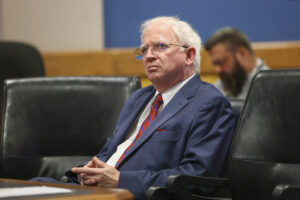Despite Subsidies, Class Sizes Rise in California Schools
Most of California's largest school districts are increasing class sizes in kindergarten through third grade, eroding the most expensive education reform in the state’s history.By Louis Freedberg and Hugo Cabrera, California WatchThis article appeared previously on California Watch.
Most of California’s largest school districts are increasing class sizes in kindergarten through third grade, eroding the most expensive education reform in the state’s history.
California Watch surveyed the 30 largest K-12 school districts in the state and found that many schools are pushing class sizes to 24 in some or all of the early grades. Other districts have raised class sizes to 30 students — reverting to levels not seen in more than a decade.
The changes at more than two-thirds of the districts surveyed have parents and teachers concerned that the academic performance of millions of children will suffer. California already ranks 48th in the nation in terms of student to teacher ratios.
And new measures are in place that will allow districts statewide to raise class sizes even higher and still receive more than $1 billion in state aid — money that was originally intended to reward schools that kept class sizes low.
The class-size reduction program was adopted 13 years ago with much fanfare. Its goal was to bring the state’s overcrowded K-3 classrooms down to a maximum of 20 students for every teacher in the lower grades. As an incentive to participate, Sacramento gave school districts a generous annual subsidy for every child — now $1,071 per child.
Carol Kocivar, California PTA’s president-elect, said that adding just four students more than the base level of 20 represents a significant increase.
“When you start inching up above 20, kids don’t get the individual attention they need,” she said.
The state has invested about $22 billion in direct subsidies into reducing class size, including $1.8 billion this school year. This is on top of billions more that individual school districts have had to pay to cover the full costs.
The program was rooted in research from other states that showed students in smaller classrooms were more successful academically.
Even though the state never implemented measurements to track the academic impact of class-size reduction, the program has been enormously popular among parents and teachers. Yet because of the state’s budget crisis, school officials are finding it harder than ever to sustain.
That’s the case in both the Mount Diablo Unified School District, in Contra Costa County, and the San Jose Unified School District. In Orange County’s Capistrano Unified School District, second and third grade classes have grown to an average of 30.5 students. In Los Angeles, which enrolls 10 percent of California’s students, K-3 class sizes are creeping up to 24 in many schools.
“In better times it is something that should be protected, but in the times we are in, it is not something we can afford to continue,” said Don Iglesias, San Jose’s superintendent, noting that raising class sizes to 30 will save his district $4 million this year alone.
At Oliveira Elementary School, in a quiet residential neighborhood of Fremont, kindergarten teacher Cheryl Accurso is adjusting to a 30-student classroom for the first time in her 11-year career.
“My worry is that with 30 kids in the class, I won’t be able to reach out and touch, and get to every child in my classroom,” she said. “When they come in the morning, I make sure I tap them on the shoulder or pat them on the head, and say their names, so that there is at least one time when I know I can get to all the children.”
California’s Superintendent of Public Instruction, Jack O’Connell, who authored the class-size-reduction legislation when he was a state senator, said that it is no accident that elementary school students in recent years have achieved significant academic gains.
“That is now in jeopardy because we have so many school districts walking away from class-size reduction,” he said.
For most of the program’s existence, schools lost the entire subsidy if the average class size hit 21. That has proved to be a powerful incentive for schools to participate. All but about a dozen of the state’s 883 eligible districts have done so.
The state Legislature has designated lower class sizes as a top priority for education spending. The program was one of a handful that escaped the budget axe this year.
At the same time, however, lawmakers acted earlier this year to make it easier for schools to abandon the program. The move allows school districts to raise K-3 classes to as high as 31 students on average — at least for the next three years. Schools that raise the class size above 25 can still receive 70 percent of the subsidies they have received in the past. In past years, K-3 classes of 22 or more students would have been denied state funding through the program.
In theory, school districts could spend more than $1.2 billion of the $1.8 billion set aside for the program on classes with 25 or more students.
Rick Simpson, deputy chief of staff to Assembly Speaker Karen Bass, and her chief adviser on education policy, said lawmakers are hoping the popularity of the program will force school districts to keep class sizes small, despite reducing the penalties for exceeding the 20-student cap. He said the goal was to give school districts more flexibility in how they spend class-size reduction funds, something they have sought for years.
But former Gov. Pete Wilson, who initiated class-size reduction when the state enjoyed a budget surplus in 1996, said the recent changes “totally defeat the purpose of the program. If you get 70 percent of the funds for doing nothing, where is that money going? It is not accomplishing the purpose for which the program was devised.”One purpose was to bring California’s class sizes down — to get them in line with those of other states. That did happen in the elementary grades. But by 2007, California had larger student-teacher ratios than every state except Utah and Arizona across all 12 grades.
Larger K-3 class sizes now threaten to push California even further behind.
“Having the largest class size in America is a crime and a shame,” said Delaine Eastin, the former superintendent of public instruction who oversaw the implementation of the class-size-reduction initiative until 2002.
It is not only poor districts that are affected. In fact, in some cases, districts serving large numbers of low-income and minority students have benefited from the additional $1.25 billion in Title 1 stimulus funds California receives from the federal American Recovery and Reinvestment Act.
And nearly 500 of the state’s lowest-performing schools are still receiving funds from the Quality Education Investment Act, passed by the Legislature in 2007. These funds have allowed school districts like Los Angeles to maintain some of their K-3 class sizes at previous levels. The Fremont Unified School District has so far been able to keep class sizes to 20 in the first, second and third grades. But in kindergarten, enrollments have risen to 30.
This year, at Oliveira Elementary, Accurso has her students sitting in groups of six, at five tables, instead of groups of four, at five tables, as in previous years. Across the yard, one of the bungalows brought to the school when the class-size reduction program began in 1996, now stands empty.
But Accurso isn’t nostalgic about the smaller class sizes.
“My focus is on the 30 kids I have in front of me and what I can do for each of them,” she said. “I can’t be thinking about what might have been. I can’t go there.”
She says she is managing with the extra kids — in part because she gets help from another teacher for about two hours, as well as parent volunteers. “We’re just worried that we won’t be able to get them where they need to be at the end of the year,” she said.
In Los Angeles, each of the district’s 524 elementary schools could choose between retaining all their teachers and keeping class sizes low — or laying off teachers and keeping support staff such as school nurses, math coaches and “intervention coordinators.” At Plummer Elementary in the San Fernando Valley, principal Angel Barrett made the painful choice to let go seven of the school’s first and second year teachers, out of a teaching staff of 45. As in many schools across Los Angeles, her classrooms are more crowded this year.
“You guys are doing a great job at listening,” Norma Plascencia, a teacher with 22 years of classroom experience, told her 24 second-graders on a recent morning, before launching into a lesson about family trees.
“It doesn’t make it impossible to teach, it just makes it harder,” she said. Plascencia said she and other teachers are doing much more advance planning to take into account the extra students. “We are not mass-producing items; we’re not making shoes or pizza. We are dealing with human beings — so four extra bodies are not just four extra bodies — it is everything that comes with them, or doesn’t come with them.”
Will it affect how her students will do this year?
“It better not,” she said. “You have to assume they can reach for the stars. Are some going to fall by the wayside? We’ll find out this year. Is there a possibility? Yes, I think there is.’’
Her comment points to the controversy that has so far been waged mostly in academic circles — whether class-size reduction makes a difference in boosting student performance. Dominic Brewer, a USC professor, said there is no compelling research showing that class-size reduction results in improved academic performance in California. What research does exist has typically been done in other states and in classrooms with even smaller enrollments than in California.
“A class of 20 may be terrible for an ineffective teacher,” he said. “And a great teacher can do great things with 30.”
Some education leaders who have been lukewarm about the program are now making the case that the funds could be better used.
“I don’t think 20-to-1 is sacred,” said L.A. schools Superintendent Ramon Cortines. More important, he said, “is the kind of quality time you spend with your students, and how you divide your time in the classroom.” To tackle high drop-out rates, he believes the real need is for smaller classes in middle and high schools, where class sizes in his district have soared to 40 and higher in some schools.
San Jose’s Iglesias said that even if the state’s economy rebounds, he’s not sure he’d put money back into the class-size-reduction program. “I’d put it into longer school days or Saturday classes rather than this,” he said.
But California superintendent O’Connell doesn’t share any of these concerns. He said his experience as a teacher in Ventura County convinced him of the merits of smaller classes.
The same goes for Doug Wheeler, a veteran kindergarten teacher in San Pablo, just north of Richmond, who said that the larger the class, the more difficult it is for teachers to “deliver the goods.” This year he volunteered to take more students into his bilingual class rather than having some of them be cut from the program. He now has 27 students.
“Teaching is not just standing in front of the class and delivering a lesson,” he said. “It’s about working with kids who are in danger of falling far behind. To get really good results, it has to be one on two, or even one on one.”
California Watch is an investigative reporting unit with offices in the Bay Area and Sacramento. It is a project of the Center for Investigative Reporting.
This story was edited by Editorial Director Mark Katches and copy edited by William Cooley.
Your support matters…Independent journalism is under threat and overshadowed by heavily funded mainstream media.
You can help level the playing field. Become a member.
Your tax-deductible contribution keeps us digging beneath the headlines to give you thought-provoking, investigative reporting and analysis that unearths what's really happening- without compromise.
Give today to support our courageous, independent journalists.









You need to be a supporter to comment.
There are currently no responses to this article.
Be the first to respond.